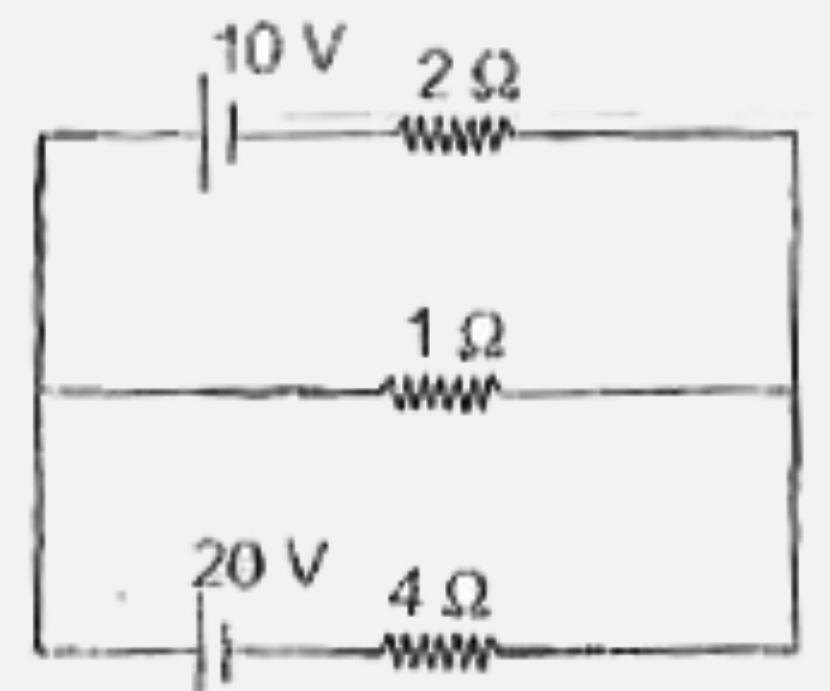What is the value of the shunt that passes 10% of the main current through a galvenomenter of 99Ω?
To find the value of the shunt resistance that allows 10% of the main current to pass through a galvanometer with a resistance of 99 ohms, we can follow these steps:
1. Understand the Current Distribution:
- Let the total main current be I.
- According to the problem, 10% of this current passes through the galvanometer. Therefore, the current through the galvanometer IG=0.1I.
- The remaining current, which passes through the shunt resistance S, is IS=0.9I.
2. Use Ohm's Law:
- The galvanometer and the shunt are connected in parallel, which means the potential difference across both is the same.
- According to Ohm's Law, the voltage across the galvanometer can be expressed as:
VG=IG×RG=(0.1I)×99
- The voltage across the shunt can be expressed as:
VS=IS×S=(0.9I)×S
3. Set the Voltages Equal:
- Since the voltages across the galvanometer and the shunt are equal, we can set them equal to each other:
(0.1I)×99=(0.9I)×S
4. Cancel I:
- Since I is common in both sides and is not zero, we can cancel it out:
0.1×99=0.9×S
5. Solve for S:
- Rearranging the equation gives:
S=0.1×990.9
- Calculating this gives:
S=9.90.9=11 ohms
6. Final Answer:
- Therefore, the value of the shunt resistance S is 11 ohms.
- Let the total main current be I.
- According to the problem, 10% of this current passes through the galvanometer. Therefore, the current through the galvanometer IG=0.1I.
- The remaining current, which passes through the shunt resistance S, is IS=0.9I.
- The galvanometer and the shunt are connected in parallel, which means the potential difference across both is the same.
- According to Ohm's Law, the voltage across the galvanometer can be expressed as:
VG=IG×RG=(0.1I)×99
- The voltage across the shunt can be expressed as:
VS=IS×S=(0.9I)×S
- Since the voltages across the galvanometer and the shunt are equal, we can set them equal to each other:
(0.1I)×99=(0.9I)×S
- Since I is common in both sides and is not zero, we can cancel it out:
0.1×99=0.9×S
- Rearranging the equation gives:
S=0.1×990.9
- Calculating this gives:
S=9.90.9=11 ohms
- Therefore, the value of the shunt resistance S is 11 ohms.
Topper's Solved these Questions
- ELECTRICAL MEASURING INSTRUMENTSBOOK - CENGAGE PHYSICS ENGLISHCHAPTER - ELECTRICAL MEASURING INSTRUMENTSEXERCISE - Solved Examples
4 Videos
- ELECTRICAL MEASURING INSTRUMENTSBOOK - CENGAGE PHYSICS ENGLISHCHAPTER - ELECTRICAL MEASURING INSTRUMENTSEXERCISE - Exercise 6.1
15 Videos
- ELECTRIC POTENTIALBOOK - CENGAGE PHYSICS ENGLISHCHAPTER - ELECTRIC POTENTIALEXERCISE - DPP 3.5
15 Videos
- ELECTROMAGNETIC INDUCTIONBOOK - CENGAGE PHYSICS ENGLISHCHAPTER - ELECTROMAGNETIC INDUCTIONEXERCISE - compression type
7 Videos
Similar Questions
A moving coil galvanometer has a resistance of 990Ω. in order to send only 10% of the main currect through this galvanometer, the resistance of the required shunt is
View SolutionA galvanometer of resistance 20Ω is shunted by a 2Ω resistor. What part of the main current flows through the galvanometer ?
View Solution
Knowledge Check
2 is 10% of what number.
A10B12C20D24
A galvanometer of resistance 150 ohm is shunted such that only 1/11 of the main current flows through the galvanometer. The resistance of the shunt is, (in ohm)
View SolutionA galvanometer has a resistance of 3663Ω. A shunt S is connected across it such that (1/34) of the total current passes through the galvanometer. Then the value of the shunt is
View SolutionA galvanometer has a resistance of 3663Ω. A shunt S is connected across it such that (1/34) of the total current passes through the galvanometer. Then the value of the shunt is
View SolutionThe value of current through 2Ω resistor is

View SolutionTo send 10% of the main current through a moving coil galvanometer of resistance 99Ω, the shunt required is –
View SolutionTo send 10% of the main current through a moving coil galvanometer of resistance 9 Ω, shunt S required is

View SolutionFind the value of :
10% of 250
View Solution
